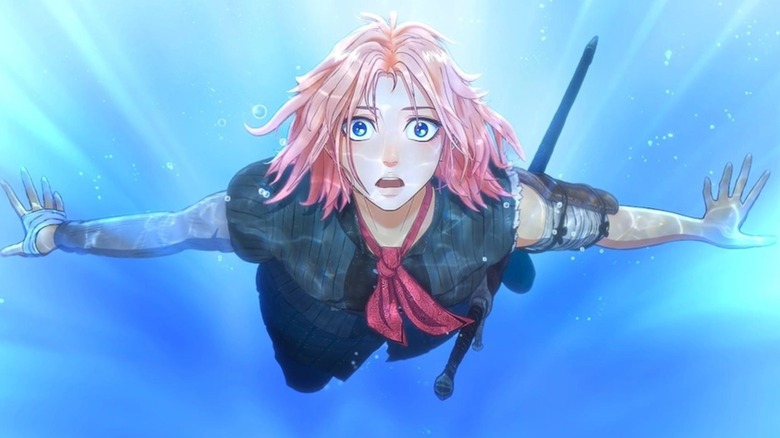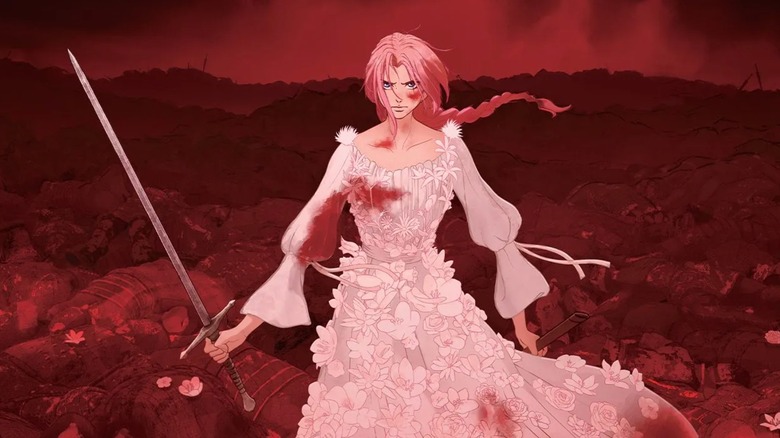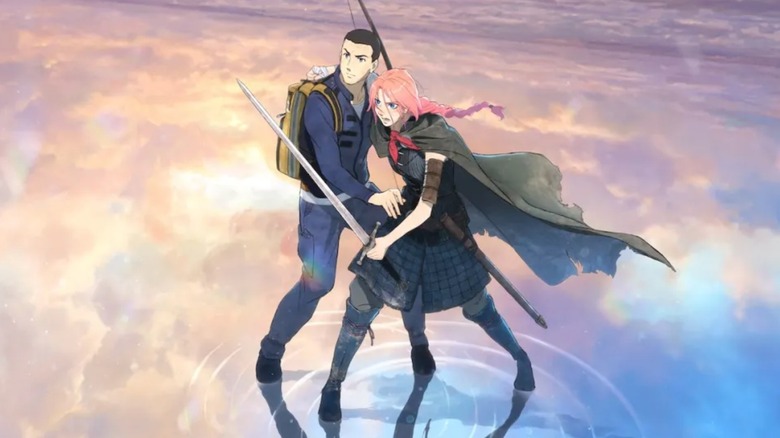Scarlet Review: Hamlet Goes Anime In Beautiful But Skin-Deep Fantasy Epic [NYFF]
Filmmaker Mamoru Hosoda is obsessed with sending his characters across time and space. In 2006's "The Girl Who Leapt Through Time," he followed a young girl who gained the ability to change her past. Then in 2018's "Mirai," he followed a young boy experiencing his family's history firsthand. Hosoda, whose earlier directorial work includes "Digimon" shorts, has revisited the idea of digital dimensions in later films "Summer Wars" and "Belle."
To represent different worlds, Hosoda has used different animation styles; 2-D animation for the "real" world, and 3-D for the digital ones. In his latest picture, "Scarlet," he again uses that contrast, but this time for epic fantasy. "Scarlet" has been promoted as a reimagining of Shakespeare's "Hamlet." In some ways it wears that influence on its sleeve, but if you're expecting a straight-up retelling of the tragedy, think again.
In 16th century European kingdom Elsinore, the life of Princess Scarlet (Mana Ashida) is changed when her ambitious uncle Claudius (Koji Yakusho of "Cure") frames her father, King Amleth (Masachika Ichimura), for treason and murders him. Scarlet spends her youth training to kill Claudius... but when the time comes, she's out-plotted and poisoned, sharing her father's fate.
General Maximus Decimus Meridius once swore "[he] would have [his] vengeance in this life or the next." Scarlet gets to put a similar vow to the test; she awakens in "Otherworld," the space between life and death where time converges. The realm and its people are a patchwork of different cultures from many eras. Even in death, the people in Otherworld still exist in conflict — including Scarlet, who embarks on an epic journey across deserts and mountains when she learns Claudius has died too and slipped into the Otherworld. She's accompanied by Hijiri (Masaki Okada), a nurse from modern day Japan who tries to heal the invisible wounds on her heart.
"Scarlet," when screened at the New York Film Festival, featured an appearance by Hosoda himself. He said (through a translator) that he wanted to write a story about revenge and forgiveness, and focused on "Hamlet" because that's a story that shows revenge ends in tragedy. As he wrote, he arrived at the question of what if the ghost of Hamlet's father had implored his son to forgive instead of seeking vengeance. The question Scarlet faces is who she must forgive.
Scarlet is a messy reinterpretation of Hamlet
Shakespeare and Japanese cinema share a common thread, that thread being master filmmaker Akira Kurosawa. Several Kurosawa films are Shakespeare adaptations with the settings transferred from Europe to Japan; "Throne of Blood" and "Ran," respectively, are "Macbeth" and "King Lear" in feudal Japan. Kurosawa gave his own shot at "Hamlet" (with a dash of "The Count of Monte Cristo") in the noir film "The Bad Sleep Well," a movie that inspired Francis Ford Coppola the way Shakespeare inspired Kurosawa. In "Scarlet," though, the Shakespeare adaptation feels much more flimsy.
Sure, the character names come from "Hamlet": Claudius marries Scarlet's mother, Queen Gertrude, and has minions named Polonius, Laertes, Cornelius, Voltemand, and Rosencrantz & Guildenstern. Claudius also paraphrases "Macbeth" and says his heart is "full of scorpions." When Scarlet confronts Claudius with her sword drawn, it's as he kneels pleading for God's mercy, just as Hamlet confronted his uncle Claudius.
Yet the movie breezes past the "Hamlet"-derived set-up in minutes, giving us only the absolute essentials to understand Scarlet and little else. Hosoda's heart seems to be much more in the Otherworld story, where Scarlet's quest truly begins. Yet that quest lacks urgency and struggles to find a good rhythm; the narrative structure of "Scarlet" can feel patchwork like the Otherworld itself. Hosoda's last feature "Belle" had some similar kitchen sink storytelling as a cyberpunk "Beauty and the Beast." The narrative of "Belle" was held together for me through effusive emotion and music, but "Scarlet" only reaches similar highs towards its end.
"Scarlet" may be an occasionally frustrating experience on the whole, but it's at least splendid to look at. Animated by Hosoda's Studio Chizu, the contrasting animation styles flow together with verve where the story doesn't always. The 2-D animation scenes, set in Scarlet's real world, are a breathtaking recreation of monarchial Europe; no detail is spared on the setting's architecture, furnishings, or fashion. That's just one more reason you'll wish the movie would spend more time in that realm.
When the movie does get to Otherworld, the beauty largely isn't lost. The fluidity and detail of Scarlet's movements — especially when she's fighting others off with her sword — make her look less like she was drawn, more like she rotoscoped. Yet the movie's critical takeaway is that there is no beauty to be found in violence.
Scarlet proves living well is the best revenge
Shakespeare himself adapted "Hamlet" from the Norse legend of Amleth (the direct inspiration for Robert Eggers' 2022 Viking film "The Northman"). Watching "Scarlet" and hearing Hosoda talk about how he wanted to tell a story about forgiveness for a world that's currently filled with conflict, I couldn't help but think of the Viking-era manga/anime "Vinland Saga." That's another Amleth-derivative revenge tale that condemns violence in the end. Yet "Scarlet" stumbles in reaching that shared goal.
By adapting a Western story with "Scarlet," Hosoda brings along Christian themes of forgiveness and life after death. Otherworld is neither Heaven nor Hell and Scarlet notes with some bemusement how people expect to arrive at one of the two. One of the movie's more striking sequences pulls from, of all things, "A Christmas Carol," as Scarlet imagines herself falling to Hell where an empty coffin waits for her.
If you die in Otherworld, only nothingness awaits, but there is word of an "Infinite Land" where death cannot touch you. Claudius becomes a false Christ figure, promising to lead those who follow him to eternal life. Scarlet is the one who learns to be truly Christlike; not through picking up a Bible, but the wisdom of Hijiri. The conceit of pairing the two is that one of them is a cynic driven to take lives, while the other's job is to save them. As Scarlet gets to know Hijiri, she imagines if she might have been born in his (relatively) more peaceful time, and swears she will do her part to make the world like that.
At first, Scarlet sees only rest ahead of her once she kills Claudius. While she never directly asks herself Hamlet's most famous question, "To be or not to be," you can tell she's only chosen to be so long as her revenge is unclaimed. Hijiri helps her decide "[she] want[s] to live." She discovers her greatest epiphany on her own, though: letting go of revenge does not mean forgiving the undeserving Claudius, but forgiving herself. Dedicating yourself to revenge is an act of self-punishment that closes you off from a happier life.
I admire the sentiment but a messy story that sometimes loses sight of Scarlet herself means it has limited resonance. Like "Scarlet," this plea that we all turn our other cheeks feels fantastical at best, and trite at worst.
/Film Rating: 6 out of 10
"Scarlet" opens in Japanese theaters on November 21, 2025 before opening in America on February 6, 2026.


